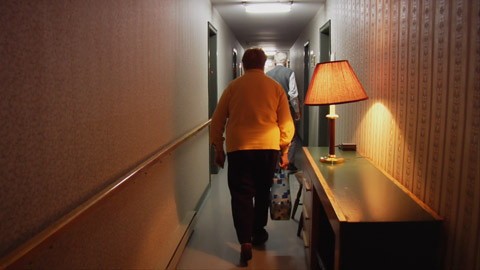Why rush to the end?
La Belle Visite gives audiences a humble look at the slowing pace of growing old
Old people tend to do one of three things for me: slow me down, depress me, or make me speak loudly and enunciate so audaciously that I sound like I think I’m onstage.
They are often indecisive, technologically inept, and they rarely conform to simple traffic cues, such as The Friendly Wave – I let you in Grandma, you had best politely acknowledge that!
Young Canadian director Jean-FranÇois Caissy’s 2010 documentary La Belle Visite changed my perspective on the elderly by using his camera to slow me down to the pace of old age.
Set on the shore of a tranquil Quebec countryside, La Belle Visite follows the everyday lives of a group of seniors living in a retirement home where no one is ever in a rush except for the cars on the nearby highway.
The beautifully muted colours of the Quebec sky complement the contented demeanor of those living in this peacefully secluded home.
Caissy’s camera carefully and deliberately moves at the same painfully slow speed that the elderly characters’ bodies allow them to.
The mirroring of the filming style with the characters’ movements forces the audience to appreciate how much effort is required of the elderly in order to perform one simple task like walking down a hallway, or getting up out of an armchair.
It also reflects the struggle between the body’s fading capabilities and the soul’s perseverance that occurs in old age.
Caissy’s directing style is much more observant than intrusive. The film has no interviews and doesn’t indulge the audience’s craving to get to know the characters.
This leaves the viewer feeling slightly unfulfilled, however, as though this film was not meant to be didactic in any way. It conveys a reflection of the waiting, tedium, monotony and irony that can transform old age from a dreaded hindrance to a dignified, contemplative period that requires no rush and abandons the curse of time that haunts us in our youth.
Perhaps many of the elderly are so slow because the only thing left for them to rush to is the end.
La Belle Visite beautifully illustrates the unique patience, subdued humour and poignancy that are possible only in the last stages of our lives.
Now, when I’m behind an old lady at Wal-Mart who doesn’t understand which buttons to press on the debit machine, I’ll smile and wait patiently while I think about how wonderful life will be when I don’t have to rush anywhere either.
Published in Volume 65, Number 3 of The Uniter (September 16, 2010)







